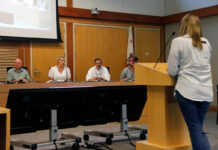Along with the dedication of a new park atop of Fitch Mountain, a community treasure has quietly slipped into the past. On a sunny Sunday in September, Fitch mountaineers gathered for a potluck at Del Rio Beach to share memories of a lake that is no more. Al Pucci, director of the Del Rio Woods Recreation and Park District, Fitch Mountain Association trustee, addressed the group and thanked everyone for their involvement and support. About 30 people came to pay their respects and share stories of their time spent on the Del Rio Woods summer lake.
The following account of Del Rio Woods was collected by Sylvia Seventy, a longtime resident of Fitch Mountain, and Jane Bonham of the Healdsburg Museum and Historical Society. In 1965, the Healdsburg Tribune reported that “Del Rio Beach is a privately owned beach that the local homeowners’ association makes available to outsiders.” The Del Rio Woods Park and Recreation District was established in 1961 by the Home Owners Association.
In 1927, two men, (R. Cook and J. Pohley) opened a subdivision named “Del Rio Woods” and several acres near the top of Fitch Mountain were reserved as a public park. Thomas Scoble of San Francisco subsequently bought the project and built a road to the top of the mountain. He then sold off most of the lots that had been reserved for the park. In order to attract summer vacationer he built a dance and band platform, a sales office, a store and a balcony with a “fine view of the river.” In 1937, a dance hall named “Palomar” was built by a new owner (E. Frampton) to replace the open platform.
In the 1930s, Scoble installed a gravel dam. In August of 1933 a lawsuit was filed against Scoble’s Del Rio Properties complaining that the dam was unsafe after it failed three times in several weeks. The County asked for a preliminary injunction against maintaining, operating or using a dam across the Russian River at Del Rio Woods.
In September of 1934, a semi-permanent dam with a permanent spillway was built. It’s kind of curious, but I guess not all that surprising, that the dam, which had passed inspection by the state’s Department of Public Works, was declared unsafe in February of 1935. Work was done in the following summer to strengthen the dam’s wing walls but in 1941 the west wing was washed away by high water.
In order to avoid the need for annual fundraising from property owners and merchants a permanent recreation district was created and in the 1950s a new permanent spillway was built. The east and west wings of the dam, which consisted of large wooden boards packed in gravel, were built up in the spring and removed in the fall.
The last summer that saw the dam built was in 2002. Concerns about turbidity and mud endangering fish survival and reproduction during the build-up and removal of the wings cause the state and local wildlife authorities to ban the annual dam installation. The permanent spillway was removed this past August.
The three Daneri sisters, Claire (Harris), Carol (Gerhardt) and Jean (McShane – who came all the way from Florida) told of their summers spent swimming in the lake. They had a summer home on Redwood drive that was built by their father in 1946.
Martha Brooks of Windsor, who was there with her son James, told of meeting her husband Wes in 1963 at a freshman girl’s “all night” party at the lake. For years, Wes was in charge of building the dam each summer and, as a helper, it was a summer job for James. She said she was on the crew that would dive down to sandbag the slow erosion around the spillway. Martha told of the “pecking order” on the dam. It seems that the high school boys would perch near the spillway; the middle school boys would sit next to them with the elementary boys being closest to shore. She also said that countless number of kids would consider themselves a “certified swimmer” if they could make it to the lake’s anchored platform and back.
Don McEnhill, the riverkeeper and executive director of Russian Riverkeeper was there along with his son Jack. As a young boy, Don would play on the lake with his sisters. He said that although the removal of the dam from a historic and sociological standpoint was sad, not having the dam’s annual disturbance is an ecological benefit for the health of the river.
Penelope La Montagne, a long-time Fitch Mountain resident who lives on the river and is a poet laureate, used to compose poetry while wading along the lake’s shore. She said that losing the lake was sad and when I asked her for something from one of her “lake” poems she gave me a line from her poem “A Five Turtle Day,” “With heart-shaped strokes, fingers together, I propel myself the bent cottonwood that signals the shoreline of home.”
Michael Haran is a Healdsburg resident.








